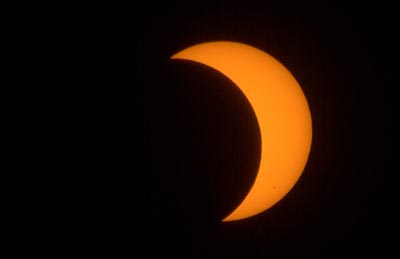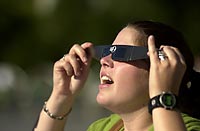 Noah
Berger photo
Noah
Berger photo |
Sky watchers
see Sun turn to crescent of fire at Lawrence Hall of Science
11 June 2002
By Diane Ainsworth, Public Affairs
Sky watchers
witnessed the Sun changing from a glowing marble to a radiant
crescent of light yesterday during a two-hour partial eclipse
that was seen from Borneo to Mexico.
The
partial eclipse drew approximately 250 astronomy enthusiasts
and nature lovers to the University's Lawrence Hall of Science,
which overlooks San Francisco Bay. Some drove up from the South
Bay to catch the light show, while others living nearby, in
Berkeley, Orinda and Oakland, stopped by to enjoy the party
and pick up free sunglasses and energy efficient light bulbs.
"Cool,"
said Forrest Lineburger, a Berkeley graduate, who drove up from
Mountain View to watch the two-hour, four-minute eclipse. "It
makes you feel miniscule."
| |

Mavees
Ahlborn uses "Eclipse Shades" to view the solar
eclipse from the Berkeley hills.
Noah Berger Photo
|
"This
is a rare and beautiful show that nature is putting on for us,"
said Toshi Komatsu, assistant director of the Hall of Science
Planetarium. "You get a solar eclipse maybe twice a year,
but you may not be in the right place to see it, so any kind
of an eclipse is always a treat."
Astronomer
Alan Gould of the Lawrence Hall of Science set up a powerful
refractor telescope with 40 times the magnification and an eclipse
filter for public viewing. A less powerful reflector telescope
with about 20 times the magnification also drew lines of people
waiting to get a glimpse of the Moon as it slid in front of
the Sun.
"It's
great to remind people that the Moon is actually moving,"
he said. "We know it orbits, but a lot of times we don't
really realize that until we see it."
At
the peak of the eclipse, which occurred at 6:16 p.m. Pacific
time, the Moon had blocked out about 70 percent of the Sun's
surface.
Few
sunspots
Three
dark sunspots, each as big as Earth, were visible in the southern
hemisphere of the Sun. Sunspots are dark, cooler regions of
the solar atmosphere with intense magnetic fields that choke
off heat and energy flowing outward from the Sun's interior,
Komatsu said. This keeps them thousands of degrees cooler than
the turbulent gas around them.
|
Sun
Facts:
-
The Sun is 92 percent hydrogen, 8 percent helium.

- About 100 times the diameter of Earth, or 109 times
Earth's radius, and 333,000 times Earth's mass.

- 15.5 billion Kelvin at its center, hot enough for fusion
to occur.

- only 70 percent as luminous at birth 4.5 billion years
ago.

- steady brightening is caused by increasing amounts of
helium accumulating in the Sun's core.

- today the Sun's surface is 300 K hotter and its radius
is six percent greater than it was 4.5 billion years ago.

- the UV rays that are most intensive during solar maximum
do not cause sunburns; most of the UV rays causing sunburns
are blocked by ozone.

- three billion years from now, the Sun will be hot enough
to boil away Earth's oceans, leaving our planet a burned-out
cinder; life on Earth will end.

- seven billion years from now, the Sun will run out of
hydrogen and balloon into a giant star, engulfing the
planet Mercury and becoming 2,000 times brighter than
it is now. |
Normally
they appear in pairs of opposite magnetic polarity, joined by
loops of magnetic field lines that rise into the overlying solar
atmosphere, Komatsu explained. There are far fewer to freckle
the Sun's face right now than there were earlier in the year
because the height of the Sun's activity has subsided.
"We
would probably see twice as many sunspots during solar maximum,"
Komatsu said. "The ones we see today look something like
a chain of islands."
Michele
Hubinger, a resident of Orinda, asked her four-and-a-half year
old son, Evan, to explain the eclipse. "It's the moon on
top of the Sun," he exclaimed in no uncertain terms. Hubinger
has been following eclipses ever since the late 1960s, when
her father took her to watch a total solar eclipse in Pennsylvania
and ignited her curiosity.
"I
remember that eclipse," she said, gazing skyward with her
special solar-viewing shades. "The temperature dropped
considerably and it turned from daylight to utter darkness."
During
a total eclipse, the sun's fiery atmosphere looks like a halo
of light. "We can study fine structure and detail in the
corona during a total eclipse, because the brightest part of
the Sun is blocked out," Gould said. "The corona is
about 1 million degrees Kelvin and radiates out millions of
kilometers, producing the solar wind."
Northern,
southern lights
These
gales of ionized matter blow at speeds of 1.6 million miles
per hour from higher latitudes above the Sun's equator and have
been known to disrupt power grids and telecommunications when
they collide with Earth's upper atmosphere. They also are responsible
for the shimmering northern and southern auroras.
Flares,
loops and prominences all create a "magnetic carpet"
over the Sun's surface and are the subject of several international
space science missions, including RHESSI,
a NASA/UC Berkeley satellite launched on Feb. 5, 2002. Solar
physicists are using the RHESSI spacecraft to image flares in
x-ray wavelengths as they tear away from the Sun's corona. Flares
are thought to signal the release of tremendous amounts of magnetic
energy, like a tightly twisted rubber band that suddenly snaps.
Scientists
will learn more about flares and other solar eruptions during
the next total solar eclipse, which will be visible on Dec.
4 in Africa and Australia.
|